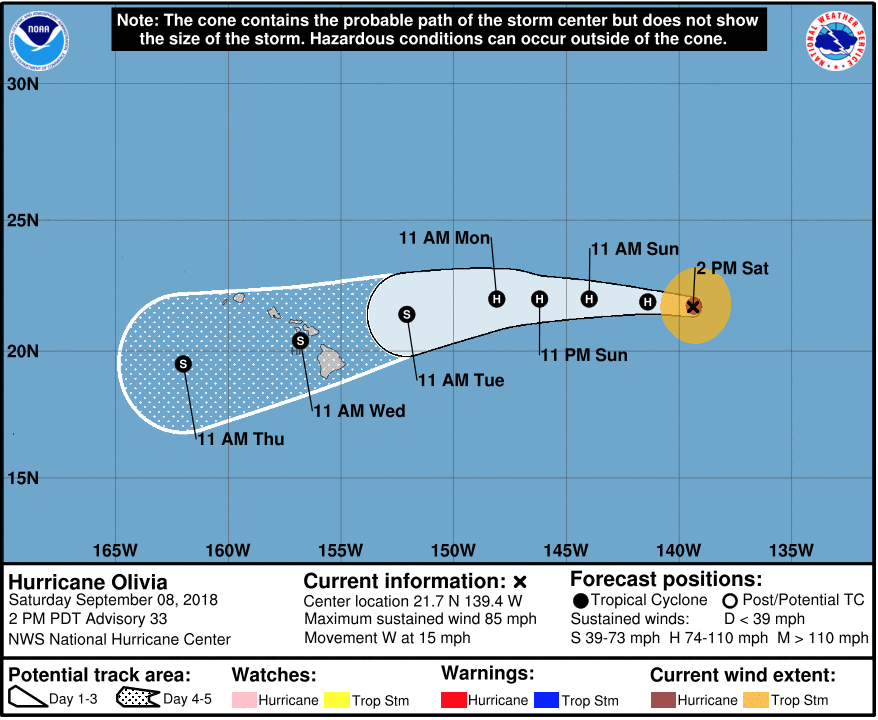Active Hurricane Season Comes on 26th Anniversary of Iniki
National Oceanic and Atmospheric Administration
Hurricane Olivia is expected to reach the islands as either a low-end hurricane or high-end tropical storm on Tuesday, the same day Hurricane Iniki struck 25 years ago.
[Editor’s note: This story includes a correction.]
Tuesday will make 26 years since Hurricane Iniki struck Hawaii as a Category 4 storm, the strongest hurricane to strike the islands in recorded history, causing an estimated $3 billion in damages. In addition to Iniki’s 25th anniversary, Hurricane Olivia is also expected to reach the islands on Tuesday as either a low-end hurricane or high-end tropical storm.
Chaminade University sophomore Timothy Dunstan, 19, a Red Cross mass care shelter worker and case worker for the services to the Armed Forces program and general public, encourages Hawaii residents to always prepare for the worst.
“It’s when we underestimate it that we get hit bad,” Dunstan said.
Furthermore, not long ago in August, Hawaii residents braced themselves as Hurricane Lane was expected to wreak havoc amongst the islands similar to Iniki in 1992, even strengthening into a Category 5 storm at one point and eventually downgrading to a tropical storm as it traveled northwest throughout the islands.
“With Lane, everyone on Oahu prepared only to not get hit, which seemed like a false alarm,” Dunstan said. “I know Olivia, even though it’s small, it’s still a direct hit and it’s still going to be bad.”
Chaminade student from Kauai, Frederick Astrologio, 22, takes hurricanes seriously after taking into account his father’s stories of Hurricane Iniki.
“My dad used to tell me about Iniki when I was younger,” Astrologio said. “I freaked out when they announced Lane upgraded to Category 5. I thought Lane was going to be the Iniki of my generation so I made sure to prepare even though everyone else made jokes about how I shouldn’t worry because I live on Oahu now instead of Kauai, and Oahu never gets hit.”
Although the eye of storm never made direct landfall, Lane kicked off Hawaii’s hurricane season as the nation’s second rainiest tropical cyclone since 1950 and was reported to have brought more than 52 inches of rain in parts such as Mountain View, Hawaii, according to the National Oceanic and Atmospheric Administration. The impacts from Lane are now being assessed as Gov. David Ige has declared the storm a major disaster for the State of Hawaii, which includes the floods and wildfires that occurred as a result of the hurricane.
Chaminade student and Guam local Deborah Chun, 21, is familiar with the damages that storms can bring to a small island.
“Guam is even tinier than Oahu, so when we git hit, we get hit hard,” Chun said. “I can still sort of remember Super Typhoon Pongsona that hit us when I was 6 years old, and pretty much the whole island lived without power for months, especially the people living on the country side.”
NOAA’s Central Pacific Hurricane Center predicted an 80 percent chance of a near- or above-normal tropical cyclone activity for this year’s central Pacific hurricane season. NOAA defines a near-normal season to consist of three to five tropical cyclones while an above-normal season consists of six or more.
“To under prepare or ignore evacuation orders is disrespectful to the first responders,” Dunstan said. “They then have to go out and risk their lives to rescue you because you didn’t have the common sense.”
[Correction: The original version of this story incorrectly stated that it had been 25 years since Hurricane Iniki. It has been 26 years.]
